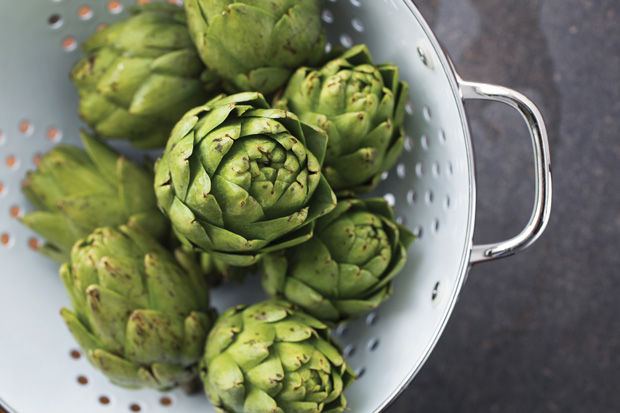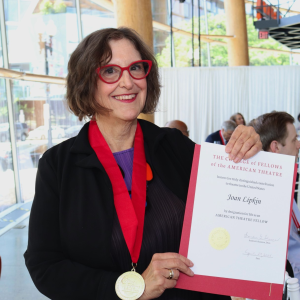Carciofi alla Giudea at last
Published June 17, 2015
Even if you don’t speak Italian, you may have heard of Carciofi alla Giudea (Jewish-style Artichokes). It’s the deep-fried whole artichoke that is the defining dish of Jewish-Roman cuisine. The opportunity to indulge in this unusually prepared and entirely edible artichoke, with its olive oil-crisped salted petals and luscious heart, was something that eluded me for years. Until now.
Call it coincidence or perhaps culinary bashert. But first, the backstory:
The Jewish-Roman community is the oldest in Europe. In 1555, the area called Portico d’Ottavia became what is now known as the Ghetto. Pope Paul IV ordered that walls be erected to segregate the Jewish population and gates built to restrict its movement. The culture of this deeply religious Jewish community absorbed various traditions, including culinary, from the Roman society in which it lived for generations.
On a trip to Europe six years ago to visit our daughter Kayla, my husband, Mike, and I spent three splendid days exploring Rome, including the Forum, Vatican, Spanish Steps, Pantheon, Trevi Fountain and, of course, the Jewish Ghetto. The history of the Ghetto came alive for us that day — the wide, cobblestone streets; narrow alleys; and the synagogue, Tempio Maggiore di Roma with its square, aluminum dome, which is still the centerpiece around which life in the Ghetto revolves.
But because of our museum schedule that day, we didn’t arrive at the Ghetto until late Friday afternoon, just as restaurants and stores were closing for Shabbat. And thus on that day, we would not get to sample the iconic artichoke, emblematic of a people determined to survive.
Fast forward to early May of this year, when Mike and I visited Florence en route to the Tuscan coast for a six-day biking trip. As coincidence would have it, the only flight we could get back home after that adventure left from Rome’s Leonardo da Vinci International Airport. We arrived in Rome with enough time before our flight to revisit our favorite sites and, finally, to sample Carciofi alla GuideaWhen we arrived at the Ghetto, it was packed with locals buying meat and groceries from the kosher markets; young boys, bedecked with tzitzit and kippahs, playing a game of catch in a back alley; and fellow tourists being ushered by anxious restaurant staff to outdoor patio tables to sample traditional Roman-Jewish kosher cuisine, including, of course, Carciofi alla Guidea.
That long-anticipated masterpiece arrived before me, centered on a white salad plate. The artichoke looked as though an artist had spent hours painting a color spectrum, from pale gold to burnished brown, onto hundreds of glasslike petals that rolled and turned this way and that. The larger leaves crunched like potato chips and, as I worked toward the center, the leaves became meatier but still just a bit crunchy. The succulent heart was tender and tasted of the earth – sweet, nutty and buttery. That amazing artichoke proved most worthy of my yearslong anticipation.
Back in St. Louis, I searched for anything I could find about Carciofi alla Guidea. I paged through old issues of Gourmet magazine and searched through cookbooks and travel books in three libraries. There wasn’t much. Then, earlier this week, our friends Patty and Jerry Padawer came over for dinner.
I mentioned my predicament, and Patty told me that I should contact her second cousin, who lives in Rome and writes an award-winning blog. She promised to email the information the following day.
In the interim, I went to a bookstore and found a new release in the cookbook section: “Eating Rome: Living the Good Life in the Eternal City,” by Elizabeth Minchilli (St. Martin’s Griffin, April 2015: $24.99, 256 pages). Paging through the book, I came across a chapter entitled “The Leaning Tower of Artichokes.” I bought the book and headed home, but not before checking my email. There I learned from Patty that her second cousin was none other than the author of the book I had just purchased. Talk about coincidence. Turns out Elizabeth grew up in St. Louis and, as a child, spent two years living in Rome with her family. She lives there permanently now with her Italian husband and their children. And though she initially pursued a career as an art historian, this is her seventh book on all things Italian, including pottery, design, architecture and, this latest, on food.
“Carciofi alla Giudea is a dish of poverty,” Elizabeth explained. “It’s an example of trying to make the most out of very little. By deep frying the artichoke, it becomes completely edible, more delicious and more nutritious.”
According to the late food historian Gil Marks, artichokes were not popular in Roman cuisine, even though the Jews had eaten them for thousands of years. They were not only unappreciated by the general population, but were described as “the most monstrous productions on the Earth” by the ancient Roman writer and naturalist Pliny the Elder.
It was not until the Jews came up with the fried version that artichokes became a beloved Roman vegetable. Once scorned, they are now incorporated into stews, served cooked or raw, marinated for a variety of antipasti and braised, as in Carciofi alla Romana.
While Carciofi alla Guidea, the Jewish fried version, originated in the Jewish community, Elizabeth said that many Roman restaurants outside the Ghetto serve them. However, she said without hesitation, “The best ones are definitely still to be found in the Ghetto.”
Mike and I had cycled past Tuscan fields of stunning purple Roman globe artichokes, the best ones from which to make the popular dish. In addition to being free of chokes, they have longer edible stems and are less prickly. This makes prepping them for their hot oil bath easier and more pleasant. And while this variety is only in season from March through May in Italy, other smaller artichoke varieties, grown in southern cities such as Sicily and Sardinia, can be substituted.
Though I’ll always cherish the experience of eating Carciofi alla Guidea in the center of the Roman Jewish Ghetto, I was tempted to try to re-create the dish here in St. Louis. I couldn’t find a recipe in Elizabeth’s beautiful cookbook, so I asked whether she has ever made them.
“I don’t include a recipe for fried artichokes since I never, ever try to do them at home,” she said. “Too much trouble and too easy to have them at a restaurant.”
So then, how to proceed? After looking at a number of recipes and doing some experimentation, I created the recipe below (I can assure you that the artichokes absorb very little of the oil). However, because our artichokes are not locally grown, they tend to be older and tougher and, of course, have a large choke that must be removed before cooking. Therefore, I would recommend that you look for fresh baby artichokes, which are choke-free and tenderer.
If you are not planning a trip to Rome and are leery of attempting to re-create this masterpiece in your home kitchen, next time you happen to be in New York City, pop into Giorgione’s in Soho (giorgionenyc.com), where you will find Carciofi alla Guidea on the antipasti section of the menu.
Carciofi alla Guidea
Ingredients
4 globe artichokes, heavy and firm with compact leaves
Olive oil for frying
Coarse kosher salt
4-5 fresh lemons, halved, for preparation and serving
Directions:
Prepare a large bowl of ice water. Squeeze the juice of two of the lemons into the bowl of water; stir. Add the squeezed lemons to the bowl and set aside. Have remaining cut lemons, cut-side down, on a cutting board nearby. Rinse artichokes under cold water. Pat them dry with paper towels. Using kitchen shears or a very large sharp knife, cut off an inch of the thorny tips from the leaves. Cut off a half-inch of the stem, and peel what remains. Dip artichokes into lemon water bath. Transfer to paper towels. Beginning at the top of the stem and working your way up the artichoke, break or peel off the outer leaves of the artichoke until you reach the light green, tenderer leaves. Dip artichokes in lemon water again before continuing.
With a serrated knife or sharp chef’s knife, slice the artichoke horizontally about ¾- inch above the base (heart) to remove the pointy top of the artichoke, leaving a flat crown of leaves on the base of the artichoke while exposing the inner purple leaves.
Slice the artichoke in half lengthwise (or into quarters), splitting the stem and heart in half vertically to reveal the inner fuzzy choke. Scoop out the fuzzy spines and purple leaves from each artichoke half with a serrated grapefruit spoon or melon baller, leaving behind two hollowed out halves of heart, each with a small crown of flat leaves.
Rub the artichokes well with a lemon half and then submerge them in lemon water while heating the oil.
In a deep, medium saucepan or deep fryer, heat at least 4 inches of olive oil to 220 degrees. Drain and pat dry with paper towels as many artichoke halves as will fit in your pot without touching each other.
Set a layer of paper towels near your pot. Carefully lower artichokes into the hot oil and fry for 12-15 minutes, or until they are tender when pricked with a fork. Using a slotted spoon or spider, lift artichokes onto the stack of paper towels, cut side down. When cool enough to handle, gently open leaves a bit.
Raise the heat of the oil to 375 degrees and lower half of the artichokes back into hot oil. Fry for an additional 30-45 seconds, or until crisp and deep brown, then lift out of oil with a slotted spoon onto paper towels. Season the fried artichokes with plenty of coarse kosher salt. Repeat with remaining artichoke halves.
Serve artichokes on small plates, garnished with lemon wedges.
Makes 4-8 appetizer servings.
Bon appetit!
Margi Lenga Kahn is the mother of five and grandmother of five. A cooking instructor at the Kitchen Conservatory, she is working on a project to preserve the stories and recipes of heritage cooks. She welcomes your comments and suggestions at [email protected].















